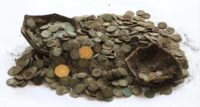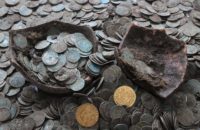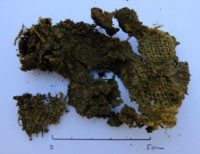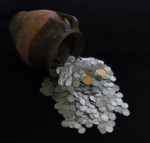 Wild boar can now join badgers as some of the most effective archaeologists of the animal kingdom. Diligent boars in the Choč mountain near Likavka, Slovakia, unearthed a large hoard of silver coins and two gold coins from the late 15th, early 16th century and then generously left them behind for a nice married couple to find during a hike. The couple had the presence of mind not to touch the coins. They alerted archaeologists and waited for three hours at the find site to ensure somebody less morally upright than they and the boars wouldn’t interfere with the treasure.
Wild boar can now join badgers as some of the most effective archaeologists of the animal kingdom. Diligent boars in the Choč mountain near Likavka, Slovakia, unearthed a large hoard of silver coins and two gold coins from the late 15th, early 16th century and then generously left them behind for a nice married couple to find during a hike. The couple had the presence of mind not to touch the coins. They alerted archaeologists and waited for three hours at the find site to ensure somebody less morally upright than they and the boars wouldn’t interfere with the treasure.
 Because of the couple’s responsible approach, Slovakian archaeologists had the extremely rare opportunity to excavate a coin hoard in situ. Usually they only see them when people show up to their offices with bags of loot and dump them out on their desks. Over an area of two square meters (about 21 square feet), archaeologists recovered more than 1600 silver Hungarian denarii.
Because of the couple’s responsible approach, Slovakian archaeologists had the extremely rare opportunity to excavate a coin hoard in situ. Usually they only see them when people show up to their offices with bags of loot and dump them out on their desks. Over an area of two square meters (about 21 square feet), archaeologists recovered more than 1600 silver Hungarian denarii.
In the shallow hole, there was the broken clay bottom of a jug with coins that were, thanks to corrosion, attached to the remains of the fabric on the inner side of the jug. Nearby, there was a metal pot-lid.
The treasure was covered by a fine layer of soil. We can assume that the person who covered the coins was in hurry. The treasure was located near to an historical trade road.
Researchers suspect that the coins were buried around 1527, a year in which a dynastic conflict over the Hungarian throne broke out between Ferdinand of Habsburg, (brother of Holy Roman Emperor Charles V) and John Zápolya, Voivode of Transylvania. John was crowned king by one faction of nobles, Ferdinand by another. While John was busy dealing with a peasant uprising, Ferdinand invaded Hungary. In September of 1527, Ferdinand’s forces, mostly German and Austrian mercenaries but with a few thousand allied Hungarian troops, soundly spanked John Zápolya’s Hungarian army. Ferdinand was crowned King of Hungary on November 3rd, 1527, but the upheavals were far from over. Zápolya regrouped and returned in 1528 with a new army. Ferdinand defeated him again, and this time Zápolya turned to the Ottoman Empire to fight his battles for him. By 1529 Suleiman the Magnificent had not only kicked the Germans and Austrians out of Hungary but was laying siege to Vienna.
 Whoever buried this hoard had a lot to lose in this war-torn period. A labourer at that time earned between 6 and 10 silver coins per day. They’d never see a single gold coin in their life and certainly wouldn’t be able to get their hands on two of them on top of thousands of silver ones.
Whoever buried this hoard had a lot to lose in this war-torn period. A labourer at that time earned between 6 and 10 silver coins per day. They’d never see a single gold coin in their life and certainly wouldn’t be able to get their hands on two of them on top of thousands of silver ones.
The coins are still being counted and cleaned. Once they’ve been thoroughly documented and researched, the hoard will be exhibited in the Liptov museum in Ruzomberok. As for the finders (the human ones), they will  reap the rewards of their conscientiousness. The monetary value of the coins will be determined by experts, and because the finders acted in total accordance with cultural heritages laws by leaving the treasure at the find site and calling archaeologists, they have earned the right to a finder’s fee in the amount of 100% of the market value. I hope they buy the boars some acorns or carrion or something with some of that cash.
reap the rewards of their conscientiousness. The monetary value of the coins will be determined by experts, and because the finders acted in total accordance with cultural heritages laws by leaving the treasure at the find site and calling archaeologists, they have earned the right to a finder’s fee in the amount of 100% of the market value. I hope they buy the boars some acorns or carrion or something with some of that cash.